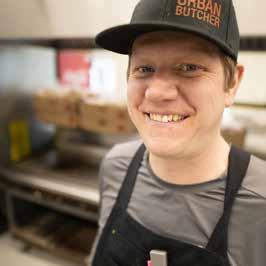
6 minute read
FOOD OF THE WEST Chef Mike Edgar serves up a brilliant Beef
BEEF WELLINGTON
1.5 Kg Beef Fillet 2 Tsp Vegetable or Sunflower Oil 2 x 50g Pack Dried Porcini Mushrooms 25g butter, plus extra for the sauce 500g (1 lb. 2oz) Shitake Mushrooms, Finely Chopped Handful Fresh Thyme Leaves 6 Slices Prosciutto 1 x 500g Pack Lighter All-Butter Puff Pastry Plain Flour, for Dusting 1 Egg, Beaten to Glaze 1/2 Cup of Dijon Mustard
Advertisement
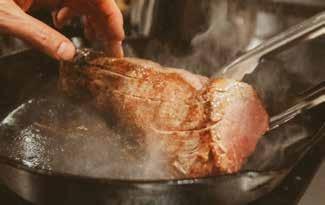
For the Sauce
500ml (½pt) Good-Quality Beef Stock 1 Bottle 750ml Shiraz
A twist on a classic. This crowdpleasing beef wellington is a perfect centrepiece for your next Christmas dinner. If it doesn’t steal the show, the side dishes definitely will!
By MIKE EDGAR Photos By TWISTED TREE PHOTOGRAPHY
METHOD
1. Season the beef with salt and black pepper. Heat the oil in a large frying pan. Sear the meat for 30 seconds on all sides until turning golden. Leave to cool. 2. Meanwhile, soak the porcini mushrooms in 250ml (8fl oz) boiling water until softened. Remove from the liquid, squeeze dry, then chop finely. Reserve the soaking liquid. 3. Heat the butter in a large frying pan. Add the mushrooms and the thyme. Cook until golden and the pan is dry (up to 20 minutes). Leave to cool completely. Reserve a quarter of the mushrooms in the pan. 4. Put two large sheets of clingfilm on a work surface, overlapping slightly. Place the prosciutto on top, overlapping the edges to make one ‘sheet’ large enough to wrap the beef. Spread with three
quarters of the mushroom mixture, then sit the meat on top and spread with the remaining mushrooms. Rub the beef with the Dijon Mustard and then roll the prosciutto around the beef, using the clingfilm. Wrap tightly and chill for 10 minutes. 5. Set aside a quarter of the pastry. On a floured surface, roll the rest into a square or rectangle big enough to wrap the fillet: approximately 35cm (14-inch) square. Trim to neaten, then roll the edges of the joining sides a little more thinly. 6. Remove the clingfilm from the beef and position it in the middle of the pastry. Wrap the pastry up along the length of the beef, overlapping slightly at the join. Brush the edges with beaten egg and seal. Fold up each end like a parcel. Transfer to a lightly greased baking tray, seam side down. Roll out the remaining pastry and cut shapes to decorate. Brush the Wellington all over with egg, press on the decorations and brush again. Chill for 20 minutes (or up to 12 hours if you like). 7. Preheat the oven to gas 8, 230°C, fan 210°C and put a baking sheet in the top third. To make the sauce, pour the wine into the pan with the reserved mushrooms. Bring to the boil and simmer until the wine has reduced to about one tablespoon. Add the stock and the porcini mushroom liquid and boil for 10 minutes until syrupy. Season, then stir in one teaspoon of butter. Set aside. 8. Put the Wellington and its tray onto the heated baking sheet in the oven and roast for 10 minutes. Reduce the heat to gas 6, 200°C, fan 180°C, then cook for another 20 minutes for medium-rare meat (15 for rare, 25 for medium). 9. Leave to rest for 10 minutes. Warm the sauce through. Serve slices of the Wellington with the sauce and vegetables.
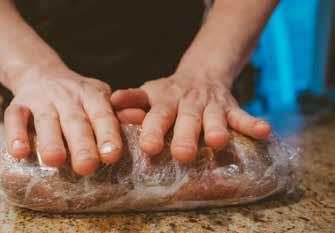

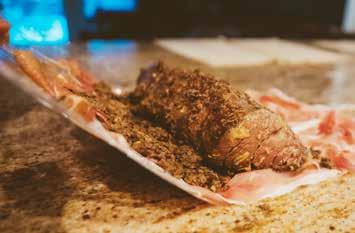
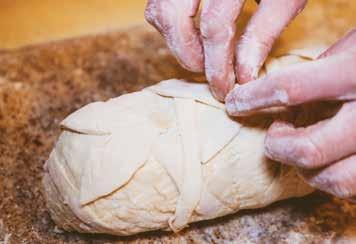
ROASTED GARLIC MASHED POTATOES
1 Bulb Garlic, Intact Olive Oil Salt and Pepper 6 Large Russett Potatoes, Peeled and Cut into 1-inch Chunks 4 Tbsp Unsalted Butter, at Room Temperature 1 Tsp Salt, Plus More as Needed 1 Cup Milk, Plus More as Needed Minced Chives, for Garnish (Optional)
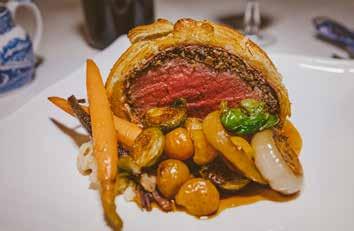
METHOD
1. Preheat the oven to 375˚ F. Use a sharp knife to slice off the top end so that the bulb remains intact and all of the cloves are exposed. Place on a piece of aluminum foil. Drizzle lightly with olive oil and season with salt and pepper. Fold the foil around the bulb so that it is completely covered and bake until the cloves are tender, about 40 minutes. Remove from the oven and let cool at least 10 minutes before handling. When cool enough to handle, squeeze the bulb so that the softened cloves fall out. Discard the peels. Use the tines of a fork to mash the roasted garlic into a paste. Set aside.
ROASTED ASPARAGUS WITH HOLLANDAISE
Roasted Asparagus
1 Bunch Asparagus Stalks 2 Tbsp. Olive Oil Large Pinch Sea Salt Black Pepper to Taste
Hollandaise for Two
2 Egg Yolks 1.5 Tsp. Lemon Juice 1/4 Cup Butter Melted Pinch Sea Salt Pinch Black Cracked Pepper
METHOD
There are lots of methods to use when making hollandaise. While I want to be a purist and use a double-boiler, I must admit – I have an immersion blender and it is pretty fool proof. These recipes easily double, triple, quadruple, etc. Make hollandaise for a crowd, by golly! Whichever method you use, here are your options:
Immersion Blender: Place egg yolks and lemon juice in a tall-sided container that isn’t too wide (think a quart-sized soup container). With the immersion blender, combine the egg yolk and lemon juice briefly. Continue to run the immersion blender and dribble in the melted butter. Add a little sea salt and black pepper. You’re done! Blender: Place egg yolks and lemon juice in the blender. Pulse briefly to combine. Turn the blender on a low setting, take either the whole lid or just that little plastic part in the top off and slow drizzle in the melted butter. Add a little sea salt and black pepper. You’re done! 2. Place the chopped potatoes in a large stockpot and cover with water. Cover and bring to a boil. Continue to cook uncovered until the potatoes are fork-tender, about 15-18 minutes. Drain well. 3. Return the potatoes to the warm pot. Add in the butter, salt, milk, and the roasted garlic paste. With an electric mixer, beat on medium-high speed until light and fluffy, adding more milk as needed. Avoid over-beating. *Taste and adjust seasoning as desired. Garnish with minced chives. Serve warm.
Double-boiler: Fill a medium pot with a few inches of water. Set on medium-high heat. Place a bowl over the top of the pot, making sure its large enough that the bottom of the bowl does not touch the boiling water underneath. Place egg yolks and lemon juice in the bowl. Begin whisking until combined. Slowly dribble melted butter in, whisking continuously. Add a little sea salt and black pepper. Finito. Stove-top: NOTE: Don’t pre-melt your butter! Simply cut the butter into little pads. Set a small saucepan over medium-low heat. Moving quickly, whisk the eggs and lemon juice together in the pan. Slowly add a pad or two of butter at a time, whisking continuously and removing the pan from the heat if you feel a curdle coming on. Add a little sea salt and black pepper. Again, you’re all finished! If however, you’re not done, and your hollandaise broke and isn’t a gloriously, smooth sauce – beat an additional egg yolk in a separate bowl and slowly whisk into the broken sauce, bit by bit. That should do the trick.
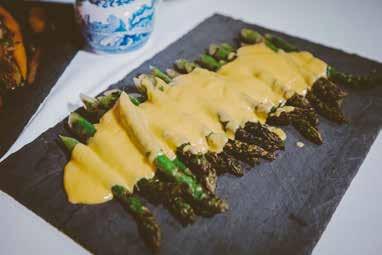
About the Chef:
Mike Edgar graduated from the Southern Alberta Institute of Technology in the Culinary Arts. He stayed in Calgary, AB working at some of the city’s top restaurants. In 2007, he opened his own restaurant in Calgary’s east end. After eight years of being a chef there, Edgar decided to take a step back and left the industry to spend more time with his son. His son has now expressed an interest in learning his father’s skills and in horses simultaneously.
